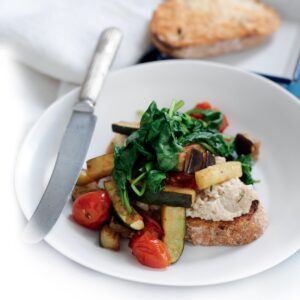
We know probiotics are good for gut health and beyond, but what we take, and when, can make a difference. Dietitian Katrina Pace explains.
Growing the ‘right’ balance of bacteria is good for our health and one of the things we can do to help rebalance our gut bacteria is to take foods or supplements that contain good bacteria.
Over recent years, research has emerged showing people with certain health conditions grow different bacteria in their body to people without those conditions. Certain bacteria are involved in producing inflammatory chemicals, energy, immune effects and neurotransmitters. In recent articles, we’ve looked into how these bacteria are involved in allergies, depression and anxiety, weight control, autoimmune conditions and immunity.
What are probiotics?
The official definition of probiotic is ‘live microorganisms that, when administered in adequate amounts, confer a health benefit on the host’. But looking on the back of a bottle of probiotics, you’d be forgiven for thinking you need to learn Latin to read the label. You’ll see names such as Lactobacillus acidophilus, Lactobacillus reuteri and Bifidobacterium breve. It’s another language. Understanding a bit more about these names could be the missing piece of the jigsaw puzzle to make the most of these useful bacteria.
How probiotics work
Just as we have antibiotics that work against different types of ‘bad’ bacteria, there is a range of ‘good’ bacteria probiotics that can help treat certain conditions. However, working out which probiotic bacteria to take for which condition isn’t that simple.
Research investigating the effects of different probiotics on different conditions can be hard to interpret as, often, a probiotic containing several different bacteria is used. Different doses and manufacturing processes may also affect the outcomes of research. Which individual strain of probiotic was used can also affect results. And finding the strains resistant to bile and stomach acidity is important, so the bacteria are protected and arrive in the bowels, where they do their work, still alive.
Different probiotic bacteria also work in different ways. Some kill or stop pathogens, some destroy harmful toxins, some protect immune cells, others prevent pathogens attaching to the host and some affect the immune system.
Bacteria basics
The two most common bacteria types found in supplements are Lactobacillus and Bifidobacterium. Lactobacillus group bacteria are one of the first groups of bacteria that colonise our bodies during birth. At about six months of age, along comes the Bifidobacterium group and, together, the two groups create an important balance within the bacteria and yeast that colonise our bodies. Lactobacillus is a group of anaerobic (doesn’t need air to live) bacteria often found in the gastrointestinal tract, vagina and mouth. There are over 180 different types of lactobacilli, which have been used in treating antibiotic-related diarrhoea, anxiety and depression and urinary tract infections. It’s one of the most common types of bacteria found in yoghurt because there’s a ready supply of lactose (milk sugar) – one of its favourite foods.
Bifidobacteria are also anaerobic. Bifidobacterium love eating (fermenting) oligosaccharides (a type of carbohydrate), including those found in milk and plants. Different species and/or strains of bifidobacteria may provide a range of beneficial health effects, including keeping gut bacteria in order and protecting the gut mucosal barrier.
What’s in your probiotic
Here’s a bit more about some of the common probiotic strains found in supplements:
Lactobacillus acidophilus
What it’s used for
Makes B vitamins, folic acid, pyridoxine and vitamin K. Used for treatment of antibiotic-related diarrhoea
Lactobacillus plantarum
What it’s used for
Helps protect the lining of the digestive system. Involved in the production of neurotransmitters
Lactobacillus reuteri
What it’s used for
Protects the body against some harmful bacteria by producing an antimicrobial substance
Bifidobacterium breve
What it’s used for
Maintaining a healthy digestive system. Enhances the immune system
Bifidobacterium longum
What it’s used for
Maintaining a healthy digestive system. May have a role in cholesterol removal
Bifidobacterium animalis/lactis
What it’s used for
Influences transit speed in the colon and reduces inflammation in the gut.
Where to find probiotics
- Capsules or powders at pharmacies added to foods such as yoghurt or drinks added to certain skin and hair products
- Live yoghurt
- Naturally fermented foods, such as kefir, kombucha and sauerkraut, traditionally fermented cheeses, sourdough breads and meats.
If you’re thinking of taking a probiotic, the evidence is fairly conclusive these probiotics work for these conditions:
Antibiotic-associated diarrhoea
Prevention
Choose a probiotic with Saccharomyces boulardii, Lactobacillus acidophilus, Lactobacillus casei or Lactobacillus rhamnosus.
Travellers’ diarrhoea
Prevention
Saccharomyces boulardii
Irritable bowel syndrome (IbS)
Bifidobacterium infantis,
Lactobacillus phantarum,
Lactobacillus rhamnosus GG,
Bifidobacterium breve
Research is still coming in, but it looks like these probiotics may help these conditions:
Weight
Lactobacillus (including gasseri and rhamnosus), Bifidobacterium lactis (more research needed)
Anxiety and depression
Bifidobacterium longum, Lactobacillus helveticus, Lactobacillus plantarum
Blood glucose
Lactobacillus acidophilus
Other tips for choosing a probiotic
- Often research seems to suggest that choosing a capsule or powder with several different probiotic bacteria may be more effective than single bacterium.
- Dose does matter. Choose probiotics with a higher CFu (colony forming unit).
- Some of the newer probiotic supplements don’t need to be kept in the fridge – always check the label.
- Including naturally fermented foods in your daily diet is a tasty way of getting probiotic bacteria.
- There are probiotic supplements that contain bacteria specific to helping conditions such as iBS, mood and candida infections.
Article sources and references
- Bloomfield SF et al. 2016. Time to abandon the hygiene hypothesis: New perspectives on allergic disease, the human microbiome, infectious disease prevention and the role of targeted hygiene. Perspectives in Public Health 136:213-24https://www.ncbi.nlm.nih.gov/pubmed/27354505
- Borgeraas H et al. 2018. Effects of probiotics on body weight, body mass index, fat mass and fat percentage in subjects with overweight or obesity: A systematic review and meta‐analysis of randomized controlled trials. Obesity Reviews 19:219-32https://www.ncbi.nlm.nih.gov/pubmed/29047207
- Chan CW et al. 2016. Environmental factors associated with altered gut microbiota in children with eczema: A systematic review. International Journal of Molecular Sciences 17:1147https://www.mdpi.com/1422-0067/17/7/1147
- Fijan S. 2014. Microorganisms with claimed probiotic properties: An overview of recent literature. International Journal of Environmental Research and Public Health 11:4745-67https://www.ncbi.nlm.nih.gov/pubmed/24859749
- Floch MH. 2014. Recommendations for probiotic use in humans: A 2014 update. Pharmaceuticals 7:999-1007https://www.ncbi.nlm.nih.gov/pubmed/25310351
- Gibson PR & Shepherd SJ. 2010. Evidence‐based dietary management of functional gastrointestinal symptoms: The FODMAP approach. Journal of Gastroenterology and Hepatology 25:252-8https://www.ncbi.nlm.nih.gov/pubmed/20136989
- Gomes AM & Malcata FX. 1999. Bifidobacterium spp. and Lactobacillus acidophilus: Biological, biochemical, technological and therapeutical properties relevant for use as probiotics. Trends in Food Science & Technology 10:139-57https://www.semanticscholar.org/paper/Bifidobacterium-spp.-and-Lactobacillus-acidophilus%3A-Gomes-Malcata/2c341488a6dd9b56722caacb93b8e80236fca97b
- Hill C et al. 2014. The International Scientific Association for Probiotics and Prebiotics consensus statement on the scope and appropriate use of the term probiotic. Nature Reviews Gastroenterology and Hepatology 11:506https://www.ncbi.nlm.nih.gov/pubmed/24912386
- Huang R et al. 2017. Efficacy of probiotics on anxiety: A meta-analysis of randomized controlled trials. Neuropsychiatry 7:862-71http://www.jneuropsychiatry.org/peer-review/efficacy-of-probiotics-on-anxiety-a-metaanalysis-of-randomized-controlled-trials-12195.html
- MacQueen G et al. 2017. The gut microbiota and psychiatric illness. Journal of Psychiatry & Neuroscience: JPN 42:75https://www.ncbi.nlm.nih.gov/pmc/articles/PMC5373703/
- McFarland LV et al. 2018. Strainspecificity and disease-specificity of probiotic efficacy: A systematic review and meta-analysis. Frontiers in Medicine 5https://www.ncbi.nlm.nih.gov/pubmed/29868585
- Ng QX et al. 2017. A meta-analysis of the use of probiotics to alleviate depressive symptoms. Journal of Affective Disorders 228:13-https://www.ncbi.nlm.nih.gov/pubmed/29197739
- Nikbakht E et al. 2018. Effect of probiotics and synbiotics on blood glucose: A systematic review and metaanalysis of controlled trials. European Journal of Nutrition 57:95-106https://www.ncbi.nlm.nih.gov/pubmed/27590729
- Reid G. 1999. The scientific basis for probiotic strains of Lactobacillus. Applied and Environmental Microbiology 65:3763-6https://www.ncbi.nlm.nih.gov/pubmed/10473372
- Vlasova AN et al. 2016. Comparison of probiotic lactobacilli and bifidobacteria effects, immune responses and rotavirus vaccines and infection in different host species. Veterinary Immunology and Immunopathology 172:72-84https://www.ncbi.nlm.nih.gov/pubmed/26809484
- West CE et al. 2015. The gut microbiota and inflammatory noncommunicable diseases: Associations and potentials for gut microbiota therapies. Journal of Allergy and Clinical Immunology 135:3-13https://www.ncbi.nlm.nih.gov/pubmed/25567038
www.healthyfood.com










